Destination Tourism at Sydney: An Analysis of Tourist Destinations
VerifiedAdded on 2021/06/17
|6
|1556
|37
Report
AI Summary
This report provides a comprehensive analysis of destination tourism in Sydney, focusing on key attractions such as the Sydney Opera House, Taronga Zoo, and Bondi Beach. It explores the application of Dean MacCannell's sight sacralisation theory and Butler's destination life cycle to understand tourist behavior and the development of Sydney's tourism industry. The report also examines different types of tourists, including psychographic and group tourists, and applies the Whole Tourism System (WTS) model to conceptualize the tourism experience. Furthermore, it analyzes the economic contribution of the tourism industry in Australia, highlighting its growth and the challenges faced, such as population boom and environmental sustainability. The study concludes by emphasizing the significance of destination traveling and the government's support for the tourism sector in Sydney. The report uses various academic sources, including journal articles and online resources, to support its findings and provide a well-rounded understanding of the topic.
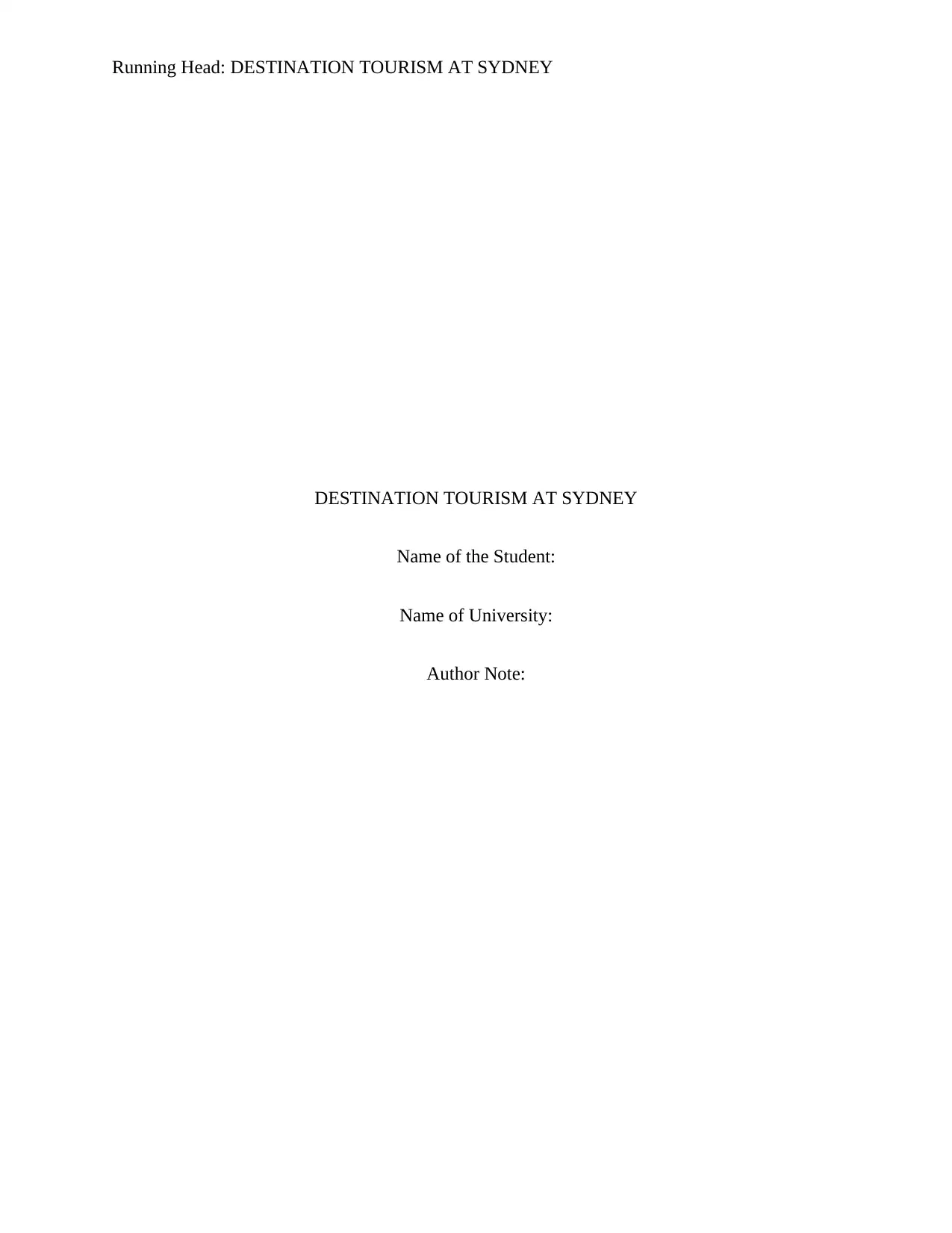
Running Head: DESTINATION TOURISM AT SYDNEY
DESTINATION TOURISM AT SYDNEY
Name of the Student:
Name of University:
Author Note:
DESTINATION TOURISM AT SYDNEY
Name of the Student:
Name of University:
Author Note:
Paraphrase This Document
Need a fresh take? Get an instant paraphrase of this document with our AI Paraphraser
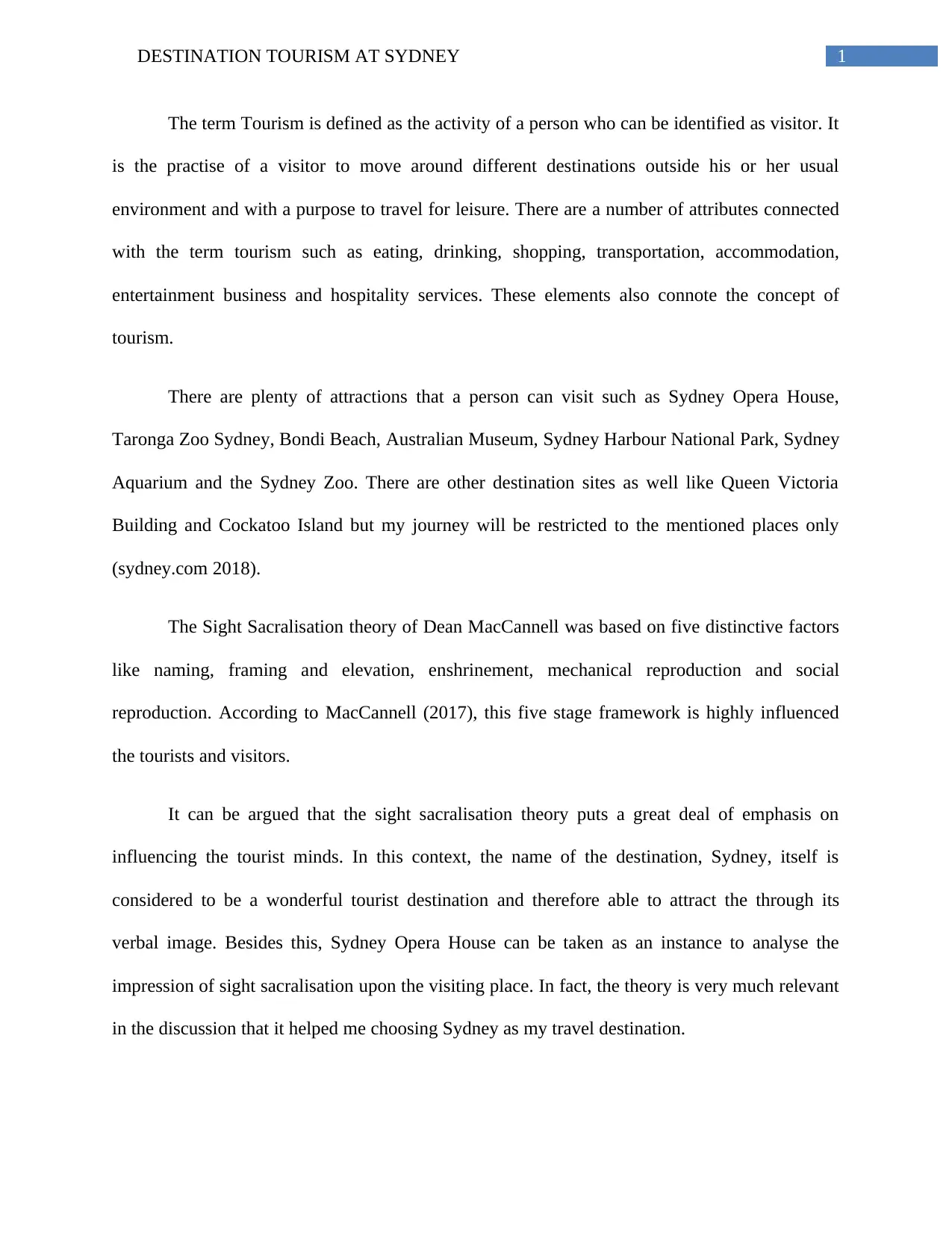
1DESTINATION TOURISM AT SYDNEY
The term Tourism is defined as the activity of a person who can be identified as visitor. It
is the practise of a visitor to move around different destinations outside his or her usual
environment and with a purpose to travel for leisure. There are a number of attributes connected
with the term tourism such as eating, drinking, shopping, transportation, accommodation,
entertainment business and hospitality services. These elements also connote the concept of
tourism.
There are plenty of attractions that a person can visit such as Sydney Opera House,
Taronga Zoo Sydney, Bondi Beach, Australian Museum, Sydney Harbour National Park, Sydney
Aquarium and the Sydney Zoo. There are other destination sites as well like Queen Victoria
Building and Cockatoo Island but my journey will be restricted to the mentioned places only
(sydney.com 2018).
The Sight Sacralisation theory of Dean MacCannell was based on five distinctive factors
like naming, framing and elevation, enshrinement, mechanical reproduction and social
reproduction. According to MacCannell (2017), this five stage framework is highly influenced
the tourists and visitors.
It can be argued that the sight sacralisation theory puts a great deal of emphasis on
influencing the tourist minds. In this context, the name of the destination, Sydney, itself is
considered to be a wonderful tourist destination and therefore able to attract the through its
verbal image. Besides this, Sydney Opera House can be taken as an instance to analyse the
impression of sight sacralisation upon the visiting place. In fact, the theory is very much relevant
in the discussion that it helped me choosing Sydney as my travel destination.
The term Tourism is defined as the activity of a person who can be identified as visitor. It
is the practise of a visitor to move around different destinations outside his or her usual
environment and with a purpose to travel for leisure. There are a number of attributes connected
with the term tourism such as eating, drinking, shopping, transportation, accommodation,
entertainment business and hospitality services. These elements also connote the concept of
tourism.
There are plenty of attractions that a person can visit such as Sydney Opera House,
Taronga Zoo Sydney, Bondi Beach, Australian Museum, Sydney Harbour National Park, Sydney
Aquarium and the Sydney Zoo. There are other destination sites as well like Queen Victoria
Building and Cockatoo Island but my journey will be restricted to the mentioned places only
(sydney.com 2018).
The Sight Sacralisation theory of Dean MacCannell was based on five distinctive factors
like naming, framing and elevation, enshrinement, mechanical reproduction and social
reproduction. According to MacCannell (2017), this five stage framework is highly influenced
the tourists and visitors.
It can be argued that the sight sacralisation theory puts a great deal of emphasis on
influencing the tourist minds. In this context, the name of the destination, Sydney, itself is
considered to be a wonderful tourist destination and therefore able to attract the through its
verbal image. Besides this, Sydney Opera House can be taken as an instance to analyse the
impression of sight sacralisation upon the visiting place. In fact, the theory is very much relevant
in the discussion that it helped me choosing Sydney as my travel destination.
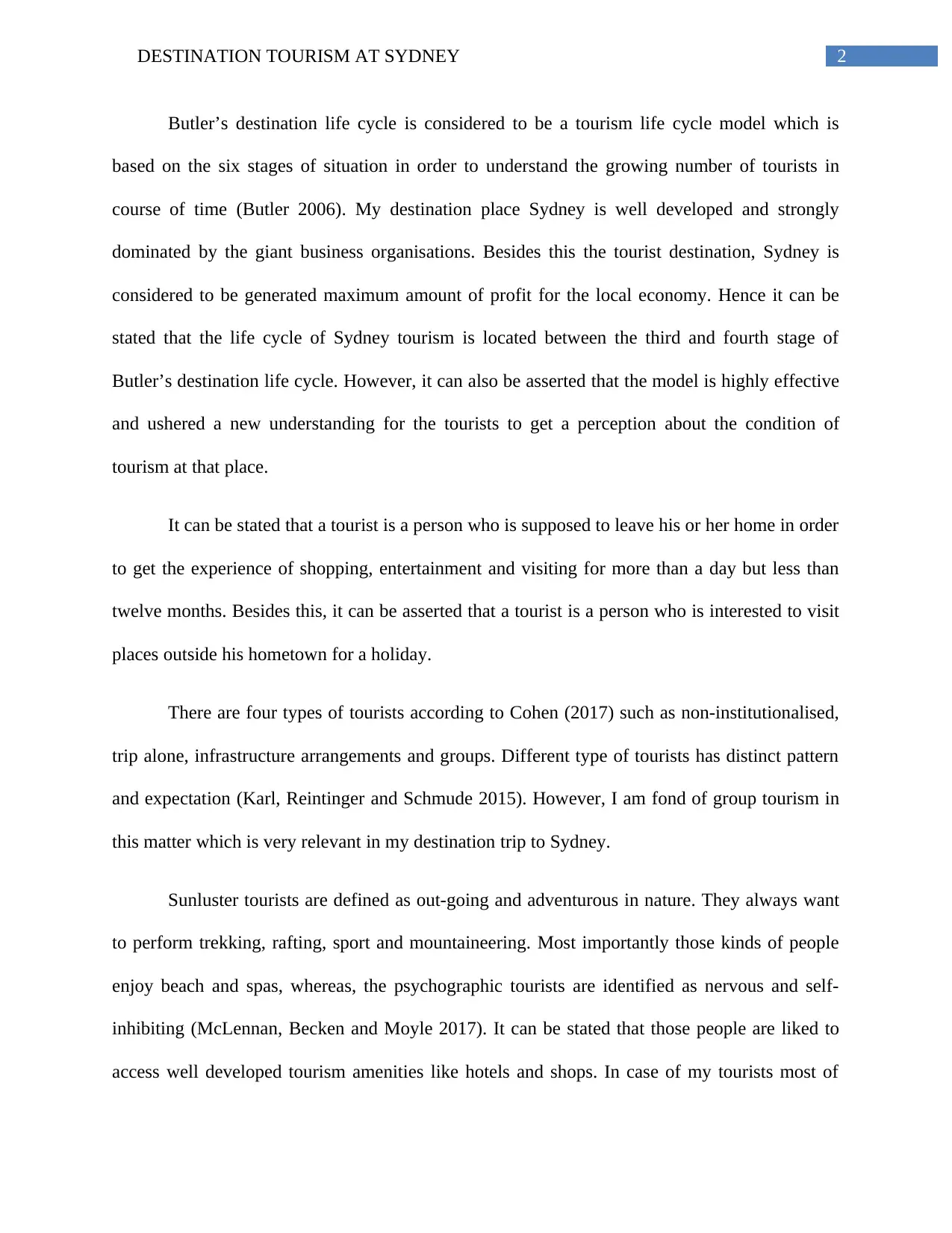
2DESTINATION TOURISM AT SYDNEY
Butler’s destination life cycle is considered to be a tourism life cycle model which is
based on the six stages of situation in order to understand the growing number of tourists in
course of time (Butler 2006). My destination place Sydney is well developed and strongly
dominated by the giant business organisations. Besides this the tourist destination, Sydney is
considered to be generated maximum amount of profit for the local economy. Hence it can be
stated that the life cycle of Sydney tourism is located between the third and fourth stage of
Butler’s destination life cycle. However, it can also be asserted that the model is highly effective
and ushered a new understanding for the tourists to get a perception about the condition of
tourism at that place.
It can be stated that a tourist is a person who is supposed to leave his or her home in order
to get the experience of shopping, entertainment and visiting for more than a day but less than
twelve months. Besides this, it can be asserted that a tourist is a person who is interested to visit
places outside his hometown for a holiday.
There are four types of tourists according to Cohen (2017) such as non-institutionalised,
trip alone, infrastructure arrangements and groups. Different type of tourists has distinct pattern
and expectation (Karl, Reintinger and Schmude 2015). However, I am fond of group tourism in
this matter which is very relevant in my destination trip to Sydney.
Sunluster tourists are defined as out-going and adventurous in nature. They always want
to perform trekking, rafting, sport and mountaineering. Most importantly those kinds of people
enjoy beach and spas, whereas, the psychographic tourists are identified as nervous and self-
inhibiting (McLennan, Becken and Moyle 2017). It can be stated that those people are liked to
access well developed tourism amenities like hotels and shops. In case of my tourists most of
Butler’s destination life cycle is considered to be a tourism life cycle model which is
based on the six stages of situation in order to understand the growing number of tourists in
course of time (Butler 2006). My destination place Sydney is well developed and strongly
dominated by the giant business organisations. Besides this the tourist destination, Sydney is
considered to be generated maximum amount of profit for the local economy. Hence it can be
stated that the life cycle of Sydney tourism is located between the third and fourth stage of
Butler’s destination life cycle. However, it can also be asserted that the model is highly effective
and ushered a new understanding for the tourists to get a perception about the condition of
tourism at that place.
It can be stated that a tourist is a person who is supposed to leave his or her home in order
to get the experience of shopping, entertainment and visiting for more than a day but less than
twelve months. Besides this, it can be asserted that a tourist is a person who is interested to visit
places outside his hometown for a holiday.
There are four types of tourists according to Cohen (2017) such as non-institutionalised,
trip alone, infrastructure arrangements and groups. Different type of tourists has distinct pattern
and expectation (Karl, Reintinger and Schmude 2015). However, I am fond of group tourism in
this matter which is very relevant in my destination trip to Sydney.
Sunluster tourists are defined as out-going and adventurous in nature. They always want
to perform trekking, rafting, sport and mountaineering. Most importantly those kinds of people
enjoy beach and spas, whereas, the psychographic tourists are identified as nervous and self-
inhibiting (McLennan, Becken and Moyle 2017). It can be stated that those people are liked to
access well developed tourism amenities like hotels and shops. In case of my tourists most of
⊘ This is a preview!⊘
Do you want full access?
Subscribe today to unlock all pages.

Trusted by 1+ million students worldwide
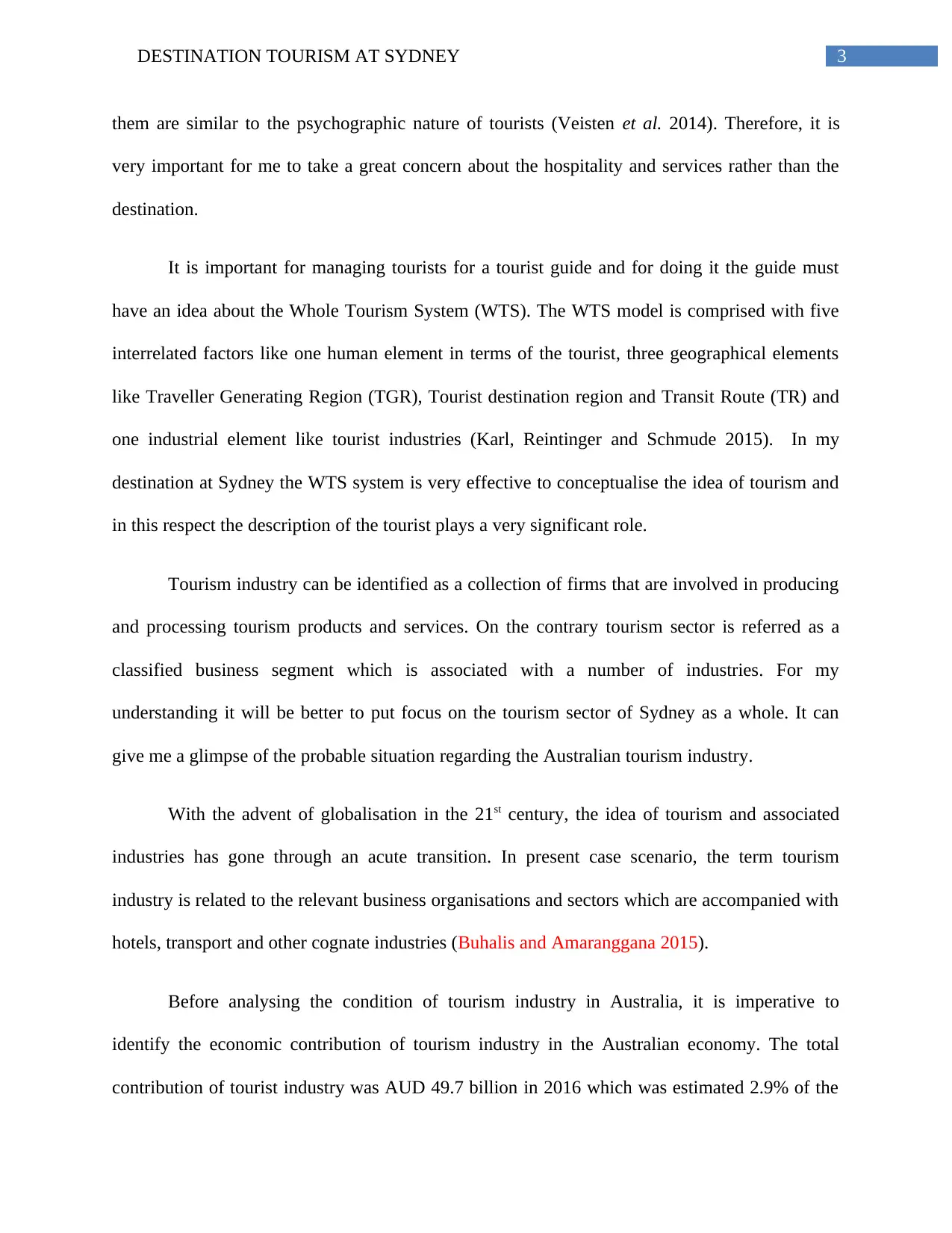
3DESTINATION TOURISM AT SYDNEY
them are similar to the psychographic nature of tourists (Veisten et al. 2014). Therefore, it is
very important for me to take a great concern about the hospitality and services rather than the
destination.
It is important for managing tourists for a tourist guide and for doing it the guide must
have an idea about the Whole Tourism System (WTS). The WTS model is comprised with five
interrelated factors like one human element in terms of the tourist, three geographical elements
like Traveller Generating Region (TGR), Tourist destination region and Transit Route (TR) and
one industrial element like tourist industries (Karl, Reintinger and Schmude 2015). In my
destination at Sydney the WTS system is very effective to conceptualise the idea of tourism and
in this respect the description of the tourist plays a very significant role.
Tourism industry can be identified as a collection of firms that are involved in producing
and processing tourism products and services. On the contrary tourism sector is referred as a
classified business segment which is associated with a number of industries. For my
understanding it will be better to put focus on the tourism sector of Sydney as a whole. It can
give me a glimpse of the probable situation regarding the Australian tourism industry.
With the advent of globalisation in the 21st century, the idea of tourism and associated
industries has gone through an acute transition. In present case scenario, the term tourism
industry is related to the relevant business organisations and sectors which are accompanied with
hotels, transport and other cognate industries (Buhalis and Amaranggana 2015).
Before analysing the condition of tourism industry in Australia, it is imperative to
identify the economic contribution of tourism industry in the Australian economy. The total
contribution of tourist industry was AUD 49.7 billion in 2016 which was estimated 2.9% of the
them are similar to the psychographic nature of tourists (Veisten et al. 2014). Therefore, it is
very important for me to take a great concern about the hospitality and services rather than the
destination.
It is important for managing tourists for a tourist guide and for doing it the guide must
have an idea about the Whole Tourism System (WTS). The WTS model is comprised with five
interrelated factors like one human element in terms of the tourist, three geographical elements
like Traveller Generating Region (TGR), Tourist destination region and Transit Route (TR) and
one industrial element like tourist industries (Karl, Reintinger and Schmude 2015). In my
destination at Sydney the WTS system is very effective to conceptualise the idea of tourism and
in this respect the description of the tourist plays a very significant role.
Tourism industry can be identified as a collection of firms that are involved in producing
and processing tourism products and services. On the contrary tourism sector is referred as a
classified business segment which is associated with a number of industries. For my
understanding it will be better to put focus on the tourism sector of Sydney as a whole. It can
give me a glimpse of the probable situation regarding the Australian tourism industry.
With the advent of globalisation in the 21st century, the idea of tourism and associated
industries has gone through an acute transition. In present case scenario, the term tourism
industry is related to the relevant business organisations and sectors which are accompanied with
hotels, transport and other cognate industries (Buhalis and Amaranggana 2015).
Before analysing the condition of tourism industry in Australia, it is imperative to
identify the economic contribution of tourism industry in the Australian economy. The total
contribution of tourist industry was AUD 49.7 billion in 2016 which was estimated 2.9% of the
Paraphrase This Document
Need a fresh take? Get an instant paraphrase of this document with our AI Paraphraser
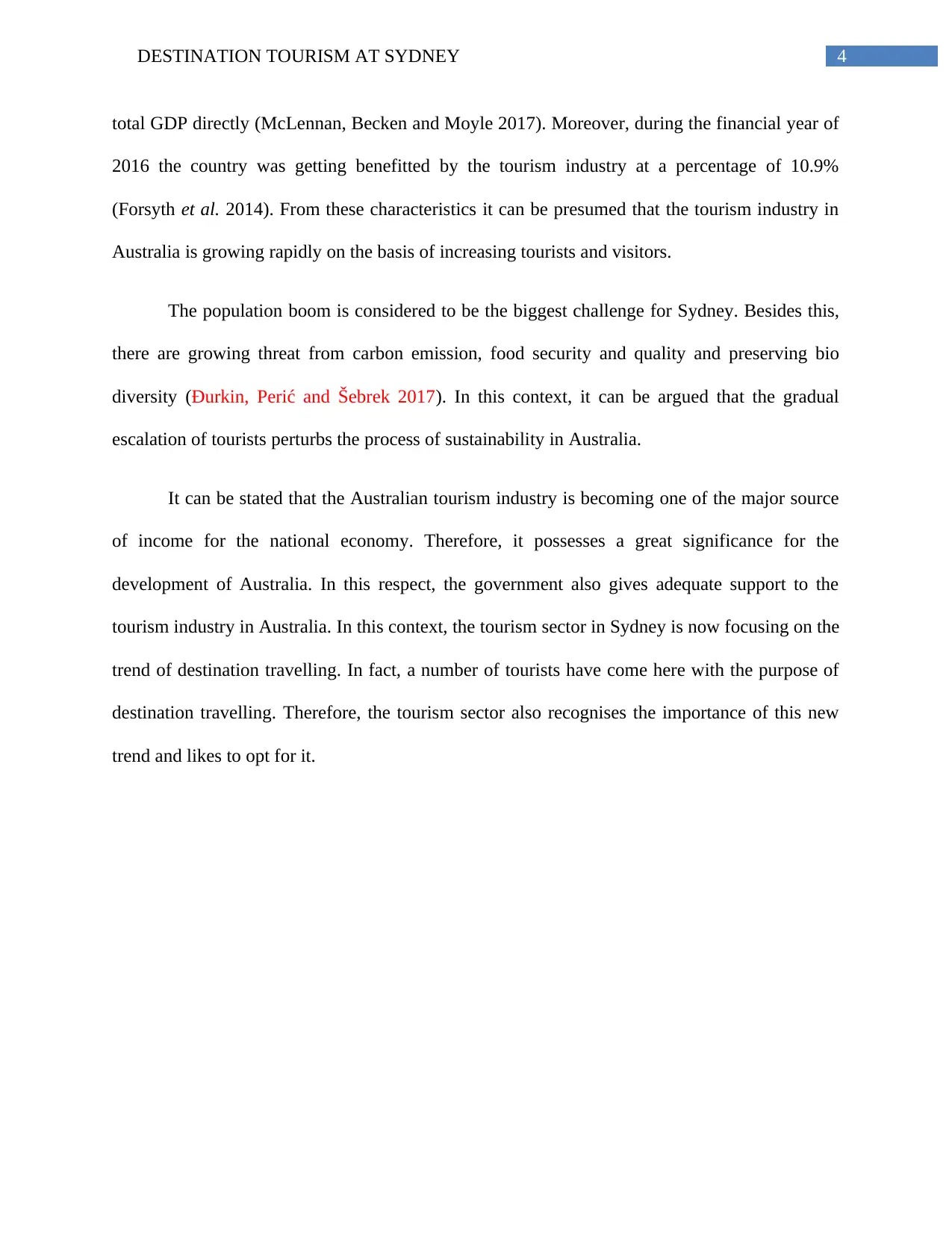
4DESTINATION TOURISM AT SYDNEY
total GDP directly (McLennan, Becken and Moyle 2017). Moreover, during the financial year of
2016 the country was getting benefitted by the tourism industry at a percentage of 10.9%
(Forsyth et al. 2014). From these characteristics it can be presumed that the tourism industry in
Australia is growing rapidly on the basis of increasing tourists and visitors.
The population boom is considered to be the biggest challenge for Sydney. Besides this,
there are growing threat from carbon emission, food security and quality and preserving bio
diversity (Đurkin, Perić and Šebrek 2017). In this context, it can be argued that the gradual
escalation of tourists perturbs the process of sustainability in Australia.
It can be stated that the Australian tourism industry is becoming one of the major source
of income for the national economy. Therefore, it possesses a great significance for the
development of Australia. In this respect, the government also gives adequate support to the
tourism industry in Australia. In this context, the tourism sector in Sydney is now focusing on the
trend of destination travelling. In fact, a number of tourists have come here with the purpose of
destination travelling. Therefore, the tourism sector also recognises the importance of this new
trend and likes to opt for it.
total GDP directly (McLennan, Becken and Moyle 2017). Moreover, during the financial year of
2016 the country was getting benefitted by the tourism industry at a percentage of 10.9%
(Forsyth et al. 2014). From these characteristics it can be presumed that the tourism industry in
Australia is growing rapidly on the basis of increasing tourists and visitors.
The population boom is considered to be the biggest challenge for Sydney. Besides this,
there are growing threat from carbon emission, food security and quality and preserving bio
diversity (Đurkin, Perić and Šebrek 2017). In this context, it can be argued that the gradual
escalation of tourists perturbs the process of sustainability in Australia.
It can be stated that the Australian tourism industry is becoming one of the major source
of income for the national economy. Therefore, it possesses a great significance for the
development of Australia. In this respect, the government also gives adequate support to the
tourism industry in Australia. In this context, the tourism sector in Sydney is now focusing on the
trend of destination travelling. In fact, a number of tourists have come here with the purpose of
destination travelling. Therefore, the tourism sector also recognises the importance of this new
trend and likes to opt for it.
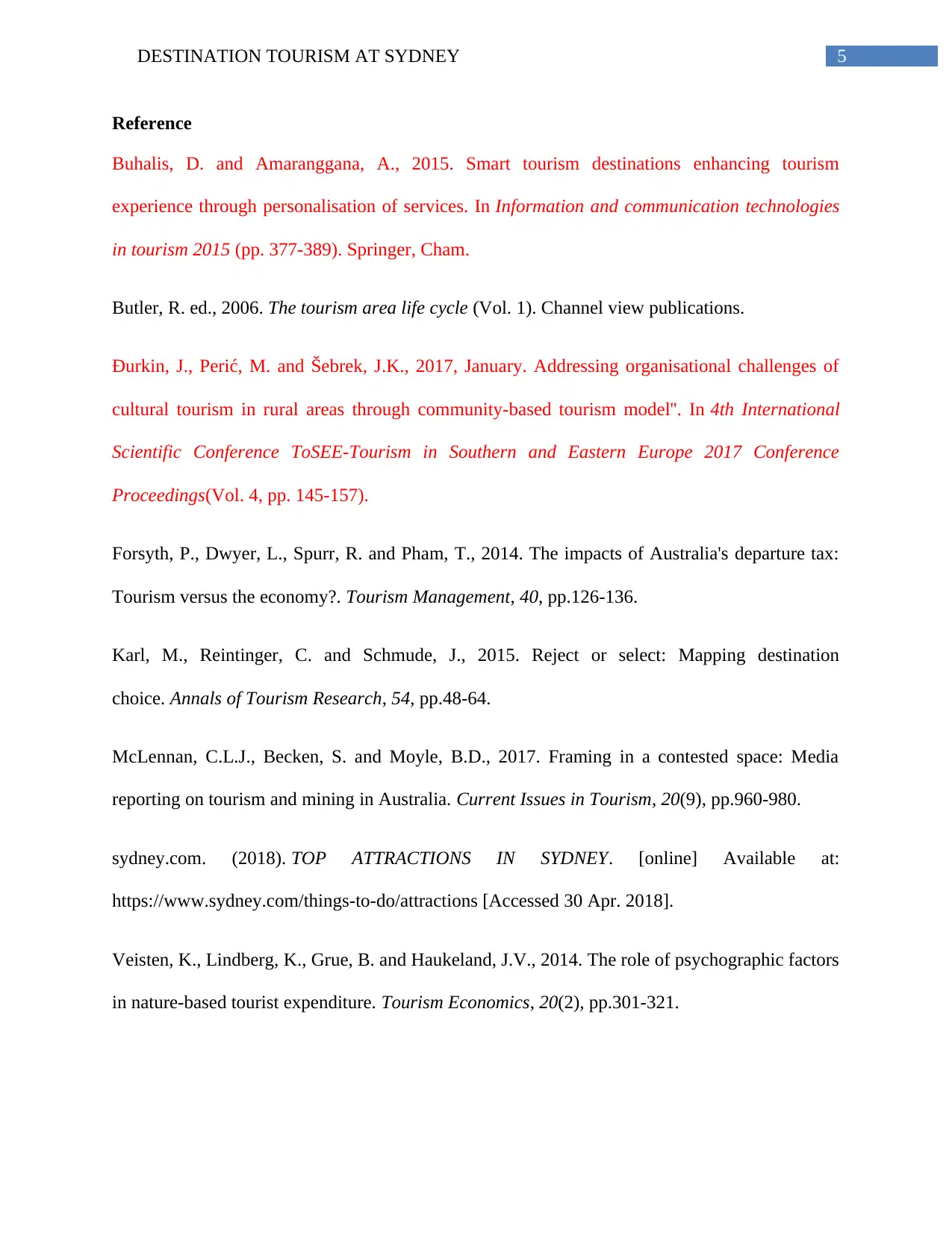
5DESTINATION TOURISM AT SYDNEY
Reference
Buhalis, D. and Amaranggana, A., 2015. Smart tourism destinations enhancing tourism
experience through personalisation of services. In Information and communication technologies
in tourism 2015 (pp. 377-389). Springer, Cham.
Butler, R. ed., 2006. The tourism area life cycle (Vol. 1). Channel view publications.
Đurkin, J., Perić, M. and Šebrek, J.K., 2017, January. Addressing organisational challenges of
cultural tourism in rural areas through community-based tourism model''. In 4th International
Scientific Conference ToSEE-Tourism in Southern and Eastern Europe 2017 Conference
Proceedings(Vol. 4, pp. 145-157).
Forsyth, P., Dwyer, L., Spurr, R. and Pham, T., 2014. The impacts of Australia's departure tax:
Tourism versus the economy?. Tourism Management, 40, pp.126-136.
Karl, M., Reintinger, C. and Schmude, J., 2015. Reject or select: Mapping destination
choice. Annals of Tourism Research, 54, pp.48-64.
McLennan, C.L.J., Becken, S. and Moyle, B.D., 2017. Framing in a contested space: Media
reporting on tourism and mining in Australia. Current Issues in Tourism, 20(9), pp.960-980.
sydney.com. (2018). TOP ATTRACTIONS IN SYDNEY. [online] Available at:
https://www.sydney.com/things-to-do/attractions [Accessed 30 Apr. 2018].
Veisten, K., Lindberg, K., Grue, B. and Haukeland, J.V., 2014. The role of psychographic factors
in nature-based tourist expenditure. Tourism Economics, 20(2), pp.301-321.
Reference
Buhalis, D. and Amaranggana, A., 2015. Smart tourism destinations enhancing tourism
experience through personalisation of services. In Information and communication technologies
in tourism 2015 (pp. 377-389). Springer, Cham.
Butler, R. ed., 2006. The tourism area life cycle (Vol. 1). Channel view publications.
Đurkin, J., Perić, M. and Šebrek, J.K., 2017, January. Addressing organisational challenges of
cultural tourism in rural areas through community-based tourism model''. In 4th International
Scientific Conference ToSEE-Tourism in Southern and Eastern Europe 2017 Conference
Proceedings(Vol. 4, pp. 145-157).
Forsyth, P., Dwyer, L., Spurr, R. and Pham, T., 2014. The impacts of Australia's departure tax:
Tourism versus the economy?. Tourism Management, 40, pp.126-136.
Karl, M., Reintinger, C. and Schmude, J., 2015. Reject or select: Mapping destination
choice. Annals of Tourism Research, 54, pp.48-64.
McLennan, C.L.J., Becken, S. and Moyle, B.D., 2017. Framing in a contested space: Media
reporting on tourism and mining in Australia. Current Issues in Tourism, 20(9), pp.960-980.
sydney.com. (2018). TOP ATTRACTIONS IN SYDNEY. [online] Available at:
https://www.sydney.com/things-to-do/attractions [Accessed 30 Apr. 2018].
Veisten, K., Lindberg, K., Grue, B. and Haukeland, J.V., 2014. The role of psychographic factors
in nature-based tourist expenditure. Tourism Economics, 20(2), pp.301-321.
⊘ This is a preview!⊘
Do you want full access?
Subscribe today to unlock all pages.

Trusted by 1+ million students worldwide
1 out of 6
Your All-in-One AI-Powered Toolkit for Academic Success.
+13062052269
info@desklib.com
Available 24*7 on WhatsApp / Email
![[object Object]](/_next/static/media/star-bottom.7253800d.svg)
Unlock your academic potential
Copyright © 2020–2025 A2Z Services. All Rights Reserved. Developed and managed by ZUCOL.

